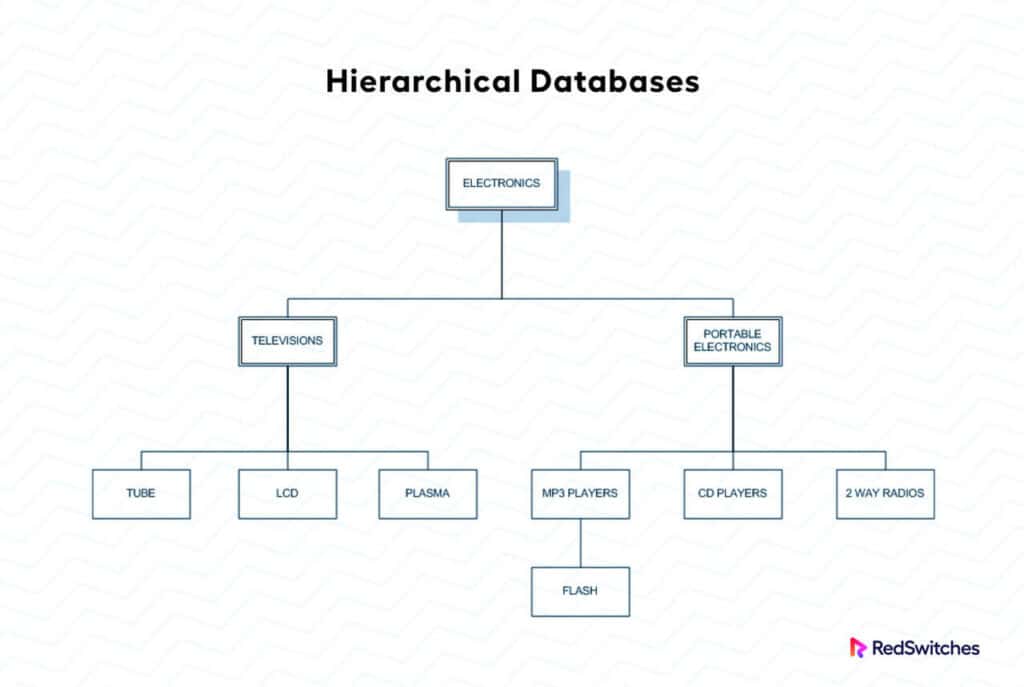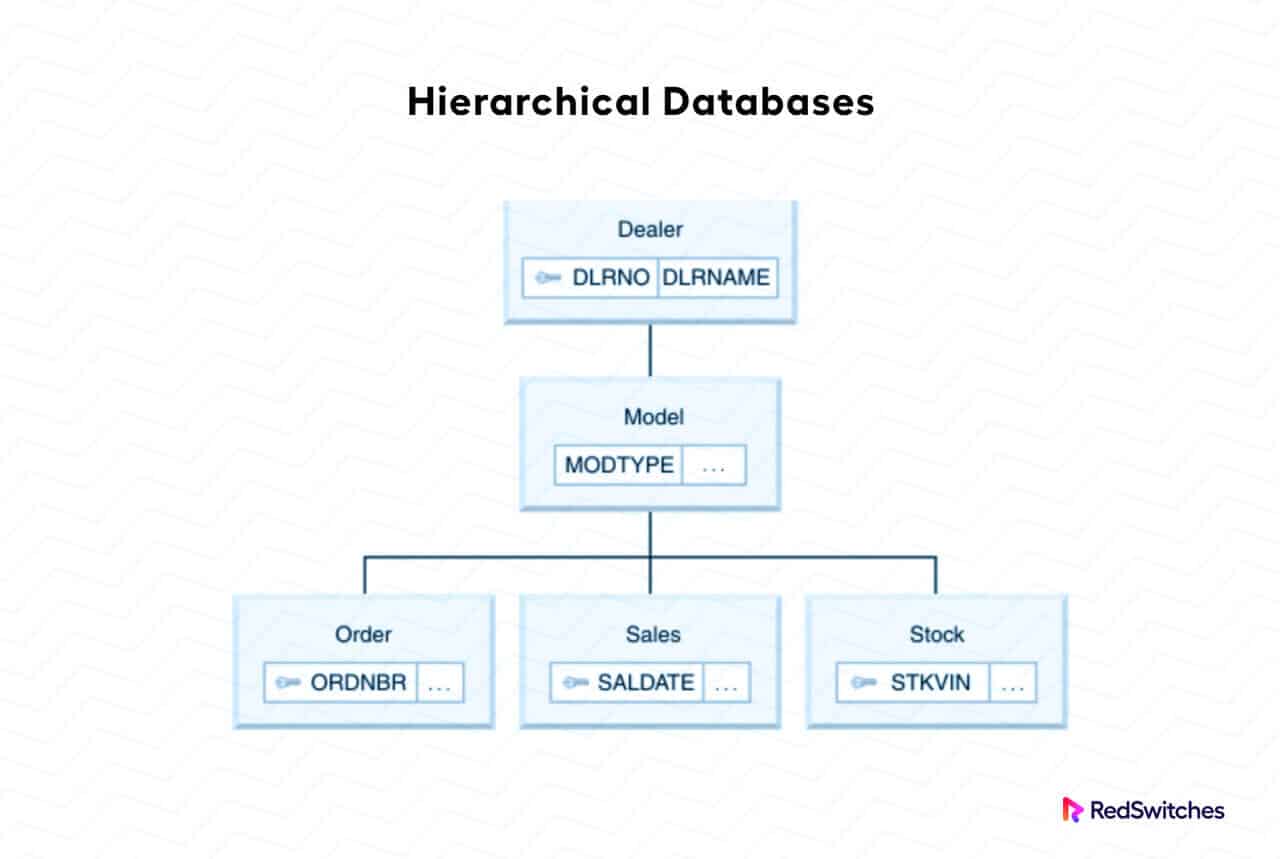Hierarchical databases are data storage systems that use a structured approach to organizing and managing data.
In a hierarchical DBMS, data is organized in a hierarchical or tree-like structure, with each data element having a parent-child connection. This structure allows for logical and well-organized data storage and retrieval.
Hierarchical databases have been used in a wide range of industries and applications. They are best suited for scenarios where you need well-defined connections between data items and an adequately defined hierarchical structure. For instance, these databases have traditionally been employed in file systems, where files and directories are organized in a tree-like structure.
In this article, we’ll look at hierarchical databases, the benefits of these systems, and how hierarchical DBMS stack against relational databases and NoSQL databases.
Let’s start with a detailed look at the hierarchical databases.
Table of content
A hierarchical database is a data storage system that organizes data in a tree-like hierarchy. Each data item in this structure is called a node. Each node has one parent node and zero or more child nodes.
Each parent node has several child nodes, but each child node has only one parent node. This simple layout allows users and query engines to traverse the database to get the desired data items.
The IBM Information Management System (IMS), initially introduced in the 1960s and is still used today, is one of the most well-known hierarchical databases. IMS is generally utilized in mainframe-based environments to manage transactional data such as financial records and inventory systems.
The Benefits of Hierarchical Databases
Hierarchical databases and hierarchical DBMS have been around since the 1960s. After all these years, they are still a popular choice for storing data and building data storage options because of the many benefits, including:
Simple Design
The simple design of hierarchical databases is one of its key benefits. Without using complicated queries or search methods, it is simple to traverse the data and quickly obtain information thanks to the hierarchical structure. Due to their ease of use and great scalability, hierarchical databases allow for quickly adding new data by adding new nodes to the tree.
Well-structured Data Storage
Hierarchical databases allow designers and users to properly organize data in a custom-designed hierarchical structure. They are, therefore, well suited to applications where the data need to be highly structured and organized, such as inventory management systems or financial record-keeping.
Efficient Data Storage
Hierarchical database design uses a parent-child relationship model to store data. This model offers efficiency in the storage of vast volumes of data. In addition, the tree-based architecture allows for streamlined data access and retrieval by taking advantage of the optimized storage.
Optimized Data Retrieval and Querying
Data retrieval and the speed of query execution are two critical benefits of hierarchical databases. These benefits are realized when users work with a huge dataset where the time required for query execution is an important performance metric. This optimization results from the structured storage format that simplifies data identification and access and speeds up specific data retrieval.
Facilitation of One-to-Many Relationships
Thanks to the structured architecture, hierarchical databases are a great way of taking advantage of one-to-many relationships. This design allows multiple child records to be connected to and accessed via a parent record. This way, complex data relationships can be effectively represented and optimized for data storage and retrieval.
The Drawbacks of Hierarchical Databases
The inflexibility of hierarchical databases is one of their key drawbacks. It might be challenging to significantly accommodate changes in the data structure, changing the database design. This happens because data is arranged in a fixed hierarchical pattern. That’s why hierarchical databases may not be an excellent fit for applications where the data is less structured and more dynamic.
Data in a highly organized, hierarchical organization can be stored effectively using hierarchical databases. They are, therefore, well suited to applications where the data is highly structured and organized, such as inventory management systems or financial record-keeping.
The Most Popular Use Cases of Hierarchical Databases
Hierarchical databases continue to be used in some specialized applications because of their strengths in storing data with a highly structured, hierarchical organization.
Hierarchical databases frequently have the following uses:
- Inventory management systems: Because the data is highly structured and arranged hierarchically, hierarchical databases are ideal for storing information about inventory items.
- Financial record-keeping: Because transaction data and account information are highly structured and organized, hierarchical databases are suitable for storing financial records.
- Network management systems: Information regarding network topologies, such as routing tables and network device setups, are highly structured. This makes hierarchical databases an excellent fit for these systems.
Using Hierarchical Databases for Operations and Querying
Hierarchical databases provide a range of operations and querying techniques for efficient data manipulation and retrieval. The available list of operations consists of the following:
- Retrieve: Fetching data based on query parameters and the parent-child relationship.
- Insert: Adding new nodes to the existing structure.
- Update: Modifying the values or relationships between existing data elements.
- Delete: Removing nodes, relationships, and their associated data from the database.
In hierarchical databases, navigating the tree structure is the primary data querying method. Specific nodes can be reached by following the hierarchy from the root node down to the desired level. This makes it possible to retrieve data quickly, especially when using optimized search algorithms for traversing the tree.
Hierarchical Databases vs. Other Database Models
The following table contrasts hierarchical databases with relational databases and NoSQL databases:
| Database Model | Hierarchical Databases | Relational Databases | NoSQL Databases |
| Flexibility | Limited | High | High |
| Relationship Support | Parent-child only | Complex relationships | Varies |
| Performance Efficiency | High | Varies | Varies |
| Scalability | Limited | Varies | High |
| Use Cases | File systems, organizational structures | Wide range of applications | Large-scale, unstructured data |
In contrast to relational databases and NoSQL databases, hierarchical databases are a more common database model. Although hierarchical databases excel in particular use cases, it’s crucial to comprehend their differences:
Relational databases: Relational databases are better suited for applications that depend upon rapidly changing data because they provide more flexibility and support complex relationships. However, some use cases that hierarchical databases may handle effectively cause relational databases to experience performance overheads.
NoSQL databases: NoSQL databases offer scalability and flexibility but may be more complex than hierarchical databases depending on the situation.
Future Trends in Hierarchical Database Technology
Hierarchical databases continue to grow and advance as technology advances in database design and implementation.
Projected future developments in the field of hierarchical database technology include:
Enhanced Scalability: Hierarchical databases will probably be able to scale more efficiently due to developments in distributed systems and cloud computing.
Flexible Hierarchy: In the future, hierarchical databases might add tools to deal with more complex relationships, giving organizations more freedom to organize and utilize data in hierarchical databases.
Integration with Other Database Models: Hybrid strategies that combine the advantages of hierarchical databases with other models may arise, providing even greater versatility in how applications use databases as part of an extensive ecosystem.
Conclusion
One of the earliest data storage systems, hierarchical databases, has existed since the 1960s. Although they may not be as versatile as more advanced data storage systems, they are helpful in a few specialized applications where they may store highly structured, hierarchical data because of their simplicity and effectiveness. Hierarchical databases may or may not be the best option for a given application, depending on its particular requirements, which should be carefully considered before making a choice.
Discover RedSwitches’ dedicated hosting for efficient hierarchical database management. Scale seamlessly, experience high performance, and prioritize data security. Customize your hosting environment to meet your specific needs. Visit our website or contact us today to learn more.
FAQs
Q1: Can hierarchical databases handle many-to-many relationships?
A1: Hierarchical databases are designed to handle one-to-many relationships efficiently. Representing many-to-many relationships can be challenging and may require alternative database models.
Q2: Are hierarchical databases suitable for large-scale applications?
A2: Hierarchical databases can be efficient for small to medium-scale applications. However, scaling them for large-scale scenarios can be complex due to their rigid structure.
Q3: How do hierarchical databases compare to graph databases?
A3: While hierarchical and graph databases represent relationships between data elements, graph databases offer more flexibility and handle complex relationships more effectively.
Q4: Can hierarchical databases be used with modern web applications?
A4: Hierarchical databases can be used with web applications, mainly when data retrieval is a primary concern. However, other database models may be more suitable for specific web application requirements.
Q5: Are there any popular hierarchical database systems available?
A5: Some popular hierarchical database systems include IBM’s Information Management System (IMS) and Integrated Data Store (IDS).


